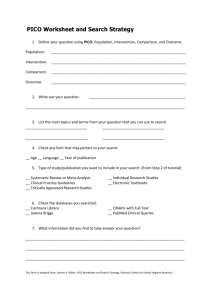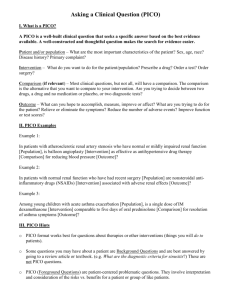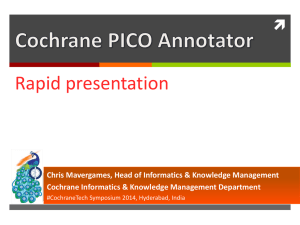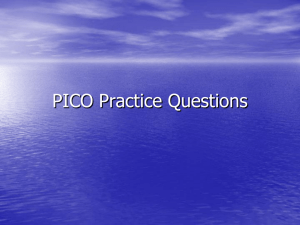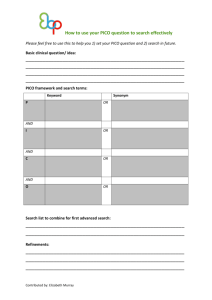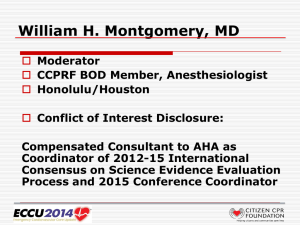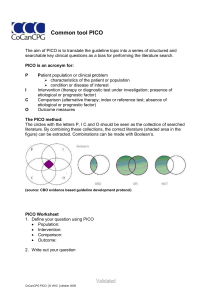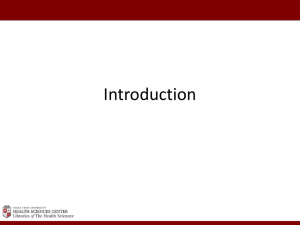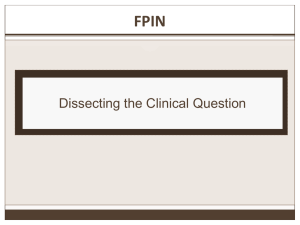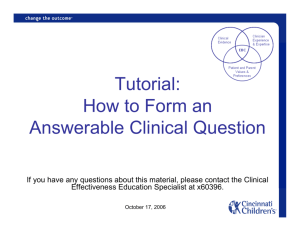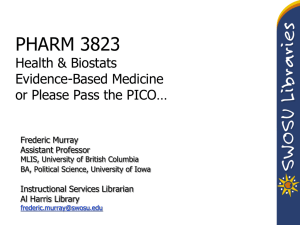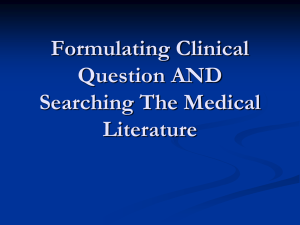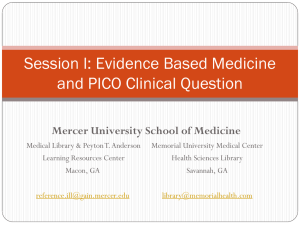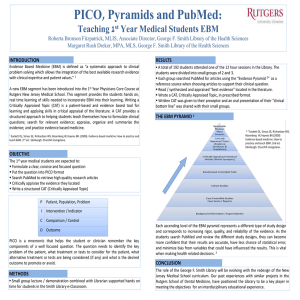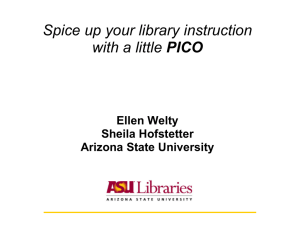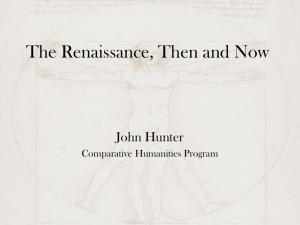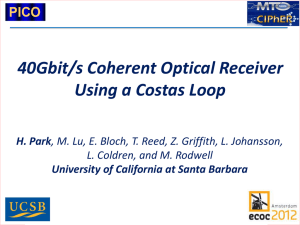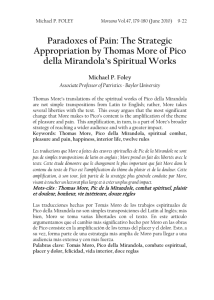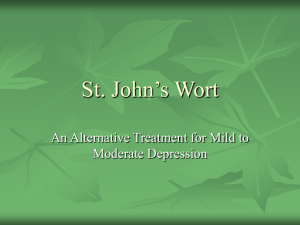Evidence Based Searching - Centre for Nursing Studies
advertisement
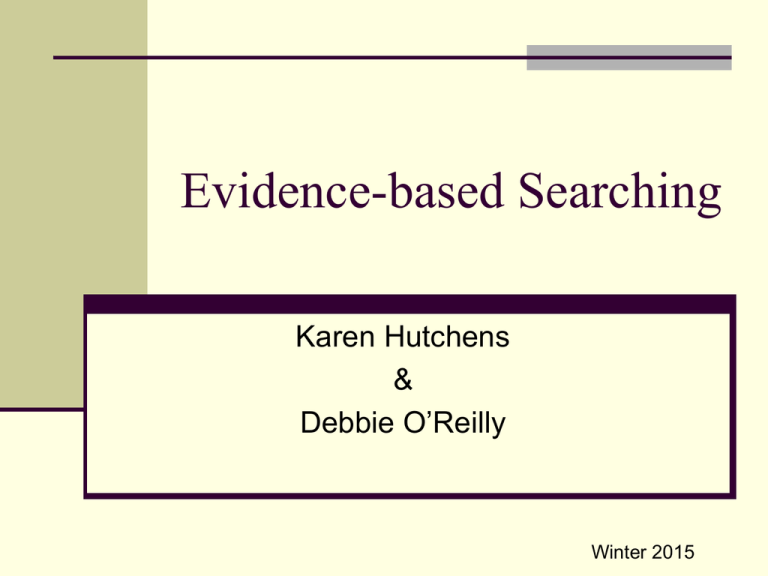
Evidence-based Searching Karen Hutchens & Debbie O’Reilly Winter 2015 Objectives To understand that there is a process to systematically search the literature to find the best available evidence To learn how to develop an answerable question using the PICO approach To identify evidence-based practice resources and learn how to use them efficiently and effectively What is Evidence based practice? Evidence-based practice is the integration of the best research evidence with clinical expertise and patient values to facilitate clinical decision making. (Sackett, Strauss, Richardson, Rosenburg, & Haynes, 2008 as cited in Neville & Horbatt, 2010) Carnwell (2001) defines EBP as the systematic search for, and appraisal of, best evidence in order to make clinical decisions that might require changes in current practice, while taking into account the individual needs of the patient. What areas of nursing practice might we want to ask EBP questions about? You might ask questions about a range of categories of practice: 1. 2. 3. 4. 5. 6. 7. 8. 9. Assessment – how to properly gather and interpret findings? Causes of the problem – how to identify them? Deciding what the problem is – where the symptoms/signs indicate a range of possible problems how do you decide which is most likely? How to select and interpret tests used to identify problems and to monitor patient progress? How to estimate the likely clinical progression of a condition/illness and any likely complications? How to select interventions that do more good than harm and that are worth the effort and cost of doing them? How to reduce the chance of the problem reoccurring or how to promote health? How to keep up to date; improve your skills; and run a more effective/efficient nursing team? How best to understand the perceptions of individuals and groups e.g. service users and caregivers? Why is best evidence and evidence based nursing important? Ensures patient/clients receive the care that fits their needs Facilitates sound decision making and makes it more explicit Minimises risk to the patient/client so that benefits outweigh harm Provides the nurse with the skills and knowledge to evaluate healthcare literature and practice Exposes gaps in knowledge and conflicts in evidence 4 Steps to Searching 1. 2. 3. 4. Design an answerable question Determine the type of question that you are posing Determine the type of study that will best answer your question Search the literature Designing an Answerable Question A well-built clinical question should have 4 components. The PICO model is a helpful tool that assists you in organizing and focusing your question into a searchable query. Dividing into the PICO elements helps identify search terms/concepts to use in your search of the literature. PICO P – population/patient/problem I – intervention C – comparison/control O – outcome (among_______) (does __________) (versus _________) (affect __________) Designing an Answerable Question Clinical scenario: Our patient is a 45-year old female who is experiencing moderate depression. After surfing the web, she believes St. John’s Wort will cure her symptoms with less risk than conventional antidepressant medications. P I C O adults experiencing (moderate) depression St. John’s Wort antidepressants relief of symptoms Clinical Question For adult patients with moderate depression, is St. John’s Wort more effective for symptom relief than antidepressants? Type of Question Diagnosis Is a yearly mammogram (I) more effective in detecting breast cancer (O) compared with every 3 yrs (C) in women under 50 (P)? Intervention/Therapy In school age children (P), what is the effect of a school-based physical activity program (I) on a reduction in the incidence of childhood obesity (O) compared with no intervention within a 1 year period (T)? Prognosis/Predictions/Natural History Does monitoring blood glucose 4 times a day (I) improve blood glucose control (O) in people with Type 1 diabetes (P) during the first 6 months after being diagnosed with the condition (T)? Etiology or Harm Are women 25-40 (P) who take oral contraceptives (I) at greater risk for developing blood clots (O) compared to women of the same age (P) who use IUD (C)? Types of Questions – Examples Are kids (P) who have obese adoptive parents (I) at increased risk for obesity (O) compared with kids (P) without obese adoptive parents (C) during the ages of five and 18 (T)? Etiology PICO Question In adult patients with total hip replacements (P) how effective is PCA pain med (I) compared to prn IM pan med © in contolling post operative pain (O)? Intervention PICO Question Is a PKU test (I) done on two week old infants (P) more accurate in diagnosing errors in metabolism (O) compared with PKU tests done at 24 hours of age (C)? Diagnostic PICO Question Type of Study Meta – Analyses Systematic, objective combining many studies – increases sample size and allows for analyses not otherwise possible Systematic Review Comprehensive survey of a topic and finds all relevant studies of highest level of evidence – reduce bias – follows formal process Randomised Controlled Trial/Studies One group receives treatment – Control group no treatment (placebo) or standard treatment – patients randomly assigned – Double Blind Method Type of Study con’t Cohort Study Prospective or historical/retrospective – pop has a certain exposure or particular treatment Case Control Studies Patients with certain condition compared with people who do not – odds of developing condition Case Reports Collections of reports on treatment of individual patients with same condition or a single patient www.biomed.lib.umn.edu Clinical Scenario #1 Clinical Scenario #1 • On morning rounds in the Oncology unit, a first year student turns to you for consultation. She wants to discuss options for managing moderate nausea and vomiting that result following chemotherapy. She shares an experience a relative had taking ginger when prochlorperazine didn’t provide effective relief and asks for your input. What is your clinical question in PICO format? What type of clinical question is this? What is the best study design to answer this type of clinical question? Answer Clinical Question #1 PICO: • P – In patients receiving chemotherapy who are experiencing moderate nausea and vomiting • I – is the use of ginger • C – as effective as prochlorperazine • O – in reducing nausea and vomiting? Type of Question: Therapy/Treatment Type of Study/Methodology: Double-Blind Randomized Controlled Trial; Systematic Review/Meta Analysis of RCT Clinical Scenario #2 Working on the Developmental Assessment Team for school-aged children of mothers who used cocaine during their pregnancy, you are interested in learning the developmental outcomes for these children as they begin school compared to children not exposed to cocaine during pregnancy. What is your clinical question in PICO format? What type of clinical question is this? What is the best study design to answer this type of clinical question? Answer Clinical Question #2 PICO: • P – (controlling for confounding factors) Do school-aged children • I – exposed in utero to cocaine, • C – compared to children not exposed to cocaine • O – have increased incidence of learning disabilities at age six years? Type of Question: Harm/Etiology Type of Study/Methodology: Cohort Studies Sources of Evidence Original research and reviews published in journals The Cochrane Library Intl organization makes available systematic reviews of effects of healthcare interventions Up-to-date PubMed/CINAHL Free provided by NLM MUN access UpTODate Evidence based clinical info Quick and easy/point of care Using PubMed Go to: www.mun.ca Click Libraries link Under Research Tools choose Articles Under Search by Subject choose Nursing Click on PubMed PubMed Home MeSH database – medical thesaurus -Can do searches from here Search Statement PubMed Mesh terms: Depression St. John’s wort Antidepressants Study type? Limits Depression Hypercium “Depressive Agents” Subheadings depression AND (hypericum OR “St. John’s Wort”) AND “antidepressive agents” Search Statement Does hand washing among healthcare workers reduce hospital acquired infections? PubMed Mesh terms: Hospital acquired infection – Cross Infection Hand Disinfection Hand washing – Nurses - Nurses "cross infection" AND "hand disinfection" AND nurses How to save results To temporarily save and print results: 1. Click the check box to the left of the citations you want to save. 2. From Send to, select Clipboard. 3. Click Add to Clipboard 4. Click Clipboard: # items to choose citations 5. Click Send to, select File - Format: Abstract(text) Create File 6. Under File select Print Remember Pick out PICO Determine question type Determine type of study Select appropriate databases & do search
